The Fifteen Hardest Genesis Games (That Are Not Battletoads)
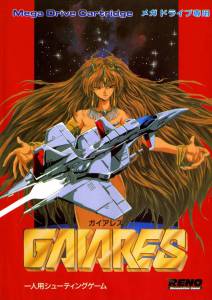
In 2015, we held a combination shouting match/kumite among the Retro Gaming Magazine staff to determine the fifteen most difficult NES games, discounting Battletoads. In the end, the local hospital told us if we pulled a stunt like that again, they would 'accidentally' mix up the oral and rectal thermometers when taking our vitals. But hey, our premiums are paid up, the casts are off, and the swelling's subsided. Figure out the fifteen most difficult Genesis games ever programmed? Challenge accepted!
There are some rules at play here though: games make the list by virtue of being programmed to perforate your colon, not for artificial reasons like sloppy controls, flabby hit detection, or incoherent game mechanics. Sorry Wayne's World, your princess is in another article. We excluded anything with Battletoads in the title for obvious reasons. The list is certified pure Mega Drive and Genesis only. Sega CD and 32X games, with their beefed up storage capacity and performance-enhancing hardware, got disqualified like a Russian Olympic team. Games are presented in no particular order, because trying to rank them would have gotten someone kidney-shanked, but we did use a ten-point rating to give readers an idea of just how harmful these things are to your sanity.
Click on the game's title to view a video of it in action (sometimes with hilarious consequences). When you're ready, grab an antacid and your favorite six-button controller--these are the fifteen Genesis/Mega Drive games guaranteed to give you sixteen-bit ulcers.
15) Gaiares (1990, Telnet Japan/Renovation)
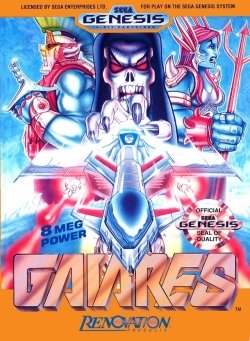
What is it?
Alexis of the Leezaluth star cluster has departed for Earth carrying the plans for the TOZ system. Unfortunately she's pursued by the terrorist organization 'Gulfer', led by the alluring but evil Zz Badnusty (I'm thinking something got lost in translation here). Her goal is to fix a planet ruined by toxic waste and systemic air pollution, returning it to the blue orb we all know and love today. Alexis hands the TOZ system off to Dan, humanity's last hero, who installs it on his ship. Now the pair must use the weapon-stealing capacity of TOZ to shoot through a never-ending gauntlet of Gulfer ships in their quest to resurrect the Earth, all to the beat of a killer soundtrack.
Why it's on this list:
If video games were rated on their difficulty the way drugs are rated on their addiction potential, Gaiares would land somewhere in 'uncut black tar heroin' territory--trying to beat it without help results in a downward spiral of agony good only for landing a guest spot on Dr. Phil. Gaiares takes the side-scrolling combat of R-Type and mixes in a secondary weapon mechanic via TOZ. TOZ downloads and copies anything it comes into contact with, meaning Dan can steal enemy tech and use it in his own ship. Repeatedly hitting enemies who carry the same weapons powers up the TOZ, enabling it to fire stronger shots. While TOZ is indestructible, Dan's ship is not, so careful piloting through the game's eight stages is your only hope. Also, while it has nothing to do with difficulty, I want to point out the Japanese box art features an obviously topless woman, which is why I used it as the thumbnail for this article. Feel free to shame me in the comments for such tasteless pandering.
Difficulty Rating: 9/10.
Any list of difficult Genesis games excluding Gaiares was penned by illiterate troglodytes (or GameSpot editors, assuming there's a difference). Despite the awful English translation and heavily-mulleted professional gamer paid to endorse it in the gaming press, Gaiares is nothing to laugh at. This is the only Genesis game that can own you by making you try and sound out the title--is it "Guy-ah-rez"? "Guy-are-us"? "Gah-ee-ah-res"? Something different? Fight it out for yourselves in the comments.
Winners must combine lightning-fast reflexes with precision shooting, and strategically alter their arsenal based on what TOZ can snatch off an enemy craft. It's easy in the heat of the action to accidentally downgrade your weaponry by latching TOZ on to a ship you didn't mean to target, and if that happens after stage 1, it was nice knowing you. You're defenseless while TOZ is deployed, so send it out only when necessary. Dan's ship is constructed to the usual levels of human incompetence that can send a pilot into space, but only by making the ship from origami paper. A single touch from a bullet, laser, rocket, floor, ceiling, wall, or enemy scatters his particles across the parsec. True to normal shoot 'em up form, dying costs you all your upgrades making Gaiares a 1-credit, no-continues affair. Difficult when first released in 1990, the only thing time has dulled with this monstrosity are your own reflexes. You can always use the invincibility cheat to see the ending, but deep inside you'll carry the shame of knowing you're a poseur, forever unworthy of Alexis's love.
14) Shadow of the Beast (1991, WJS Design/Electronic Arts)
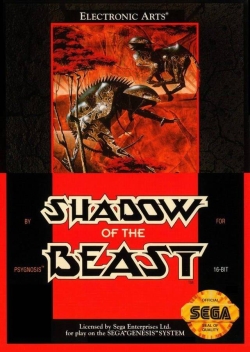
What is it?
WJS Design ported this side-scrolling action/adventure hybrid to the Genesis from Psygnosis's original 1989 Amiga version. Shadow of the Beast casts you as a guy kidnapped as an infant, and transformed into a bipedal monster to serve your new master. He's kind of a dick, but you're content to do his bidding until he kills your parents, which simultaneously breaks his hold over you and rockets him to the top of your "Assholes I Need To Throat Punch" list. In order to deliver the throat punch to end all throat punches however, you have to navigate the countryside, punching other things like rocks and bats. There's more to the game than this, but I'm sorry, there's nothing funnier than seeing a boulder bounce towards your character only to turn around and dart the other way once it makes contact with your fist. What's more, this is a phenomenon you can experience within seconds of starting up the game just by running to the left. More games should incorporate boulder-punching into their design document is what I'm getting at.
Why it's on this list:
Did anyone else notice this game's title could be abbreviated to "SOB"? If that wasn't intentional, I'll eat the box and the poster it came with. Shadow of the Beast expects you to do more than jump kick rocks to death, and it expects you to do it all perfectly. There is one proper sequence that will guarantee victory, and until you work it out, you'll have the life expectancy of a newly-conscripted Imperial Guardsman from Warhammer 40k. This wouldn't be a big deal if the game told you what you needed, where to go, or what to do when you got there, but from the start you can wander straight into places you aren't equipped to handle, and if you don't believe me, just run to the right at the beginning.
Add to this the maze-like stages that require backtracking and pixel-perfect jumps to complete, endlessly-respawning enemies, stage hazards like dripping water and random fireballs, and a punch attack with dodgy hit detection and you have a recipe for legendary frustration. The only way Psygnosis could have made this worse is with a time limit, but even they weren't completely heartless assholes. Then again, they use their own mascot as an indestructible enemy at one point. That's some I Wanna Be The Guy-level shit from before there was an I Wanna Be The Guy!
Difficulty Rating: 9.5/10.
There's no mincing words, Shadow of the Beast is on the short-list of Mega Drive titles you never turn your back on unless you want to wake up minus internal organs. It might give you 12 hit points, but until you figure out how combat works, you can lose them all on the first screen. There's no map to help if you get lost, no companions to bring relief if you're tired, and until you determine the way the developers intended you to play, it's possible to pick up power-ups you need to beat a boss only to have them run out in the middle of the boss fight, because they come with a limited duration! Ha ha, funny that--see, you only have one life, and once you take that final hit, there's no continuing. It's back to the title screen whether you're twenty seconds or twenty minutes in.
Finish this one without resorting to save states or cheat codes and you, my friend, may consider yourself gaming royalty...at least until you see the ending, which is the game's final "up yours" for all the torture it put you through. Like Gaiares, SoB has an invincibility cheat; all it will cost you is one quick in-game death, a few button presses...and your Man Card(tm).
13) Robocop vs. The Terminator (1994, Virgin Interactive)
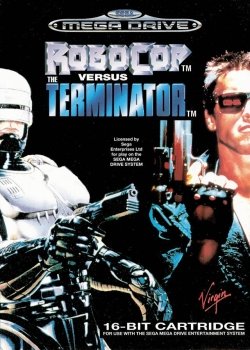
What is it?
A dark day for humanity based on a comic penned by Frank "the Goddamn Batman" Miller before he left his sanity in an upstate New York public restroom. Alex Murphy, aka Robocop, has to strike back against the forces of SkyNet in a match-up as epic as the name implies. It's cyborg vs. the cyborgs from the streets of Old Detroit to the hellscapes of a nuclear-decimated planet through ten stages of mechanical mayhem. Standing in your way are a rogue's gallery of foes from both film franchises, including Terminators (obviously), ED-209, Robocop 2, and a laundry list of everyday street scum that exist as living refutations of evolutionary theory. The future's counting on you officer, and only one directive is left: "Kick all of the ass" in this 2D side-scrolling action platformer.
Why it's on this list:
In addition to being one of the bloodiest games ever released on a 16-bit system (which can be made gorier by punching in a cheat code long enough to qualify as a landing strip for small planes), Robocop vs. The Terminator is one data spike away from being unwinnable. Murphy's one tough hombre, but even his metal-reinforced limbs have a breaking point. While your human enemies haven't a prayer of lasting long against you in a shootout, the game isn't called "Robocop vs. The Puny Fleshbags". Past level 3, Virgin Interactive throws so many exoskeletons, explosions, bullets, rockets, and plasma blasts at Murphy most players will run through their supply of lives by the time they hit the fourth boss.
Dying poses another problem for Murphy: he can carry two heavy weapons at a time and swap between them on the fly, but if SkyNet wipes him out, he comes back to life minus the gun in his hand. You're never completely unarmed, as Robocop's always got his signature Auto-9 handgun in his thigh holster, but while this is fine for putting down human scum, most enemies you face are built to take punishment and grin. While homing rockets and plasma rifles don't set the game to Kindergarten mode, losing your heavy artillery turns boss fights into endurance tests as you plink away their health a fraction of a millimeter per bullet.
Difficulty Rating: 8.5/10.
Sure there's 'Wimpy' difficulty for players who need it, but 'Wimpy' here is akin to 'hard' on most other games. 'Normal' is a nightmare unto itself, but if you cannot rest until you've shown the world how engorged your gamer testicles are, Virgin included a 'Killer' option. Whichever you pick, Robocop vs. The Terminator will rip out what's left of your human meaty bits and lubricate upon the remains. Murphy earns extra lives at the rate of one for every 10,000 points, but enemies don't respawn so you can't grind at the start to brute force the game later. Long-ass boss battles, a plethora of standard enemies that would merit 'boss' status in any game where you weren't playing as Robocop, and environmental hazards like toxic waste pits that will deactivate you instantly all combine to create one of the hardest platformers you'll find on a Sega console from any era. I also went with the Mega Drive box art, because the North American release cover failed to include vital pictorial elements on it like Robocop or the Terminator. It's a bit late now, but in case someone does invent time displacement circuitry, here's an easy change you could make that wouldn't impact our future. Use it as a practice run before you assassinate Hitler or whatever.
12) Fatal Labyrinth (1991, Sega)
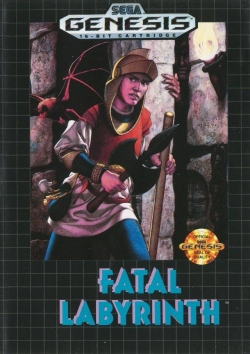
What is it?
In 1980, Michael Toy and Glenn Wichman birthed a new genre with Rogue. Primitive by today's standards, with its ASCII-art, turn-based gameplay and simple keyboard interface, Rogue pioneered in-game procedural generation. This gave it enormous depth and replayability far surpassing its contemporaries--using a simple set of rules, Rogue offered an essentially infinite number of options ensuring level layouts, monsters, and treasure differed from game to game. Blizzard borrowed this technique to enormous success with Diablo, but five years prior to Diablo, Sega decided a Rogue-like was just what their 16-bit machine needed, and thus was born Fatal Labyrinth.
You play a young man from a local hamlet who enters Castle Dragonia in search of the Holy Goblet. Standing between you and victory are thirty floors populated by a massive assortment of monsters, weapons, armor, rings, staves, scrolls, potions, treasure, traps, and food. Should you reach floor 30 and claim the Holy Goblet, you get to drink from the firehose fight the dragon who stole it. Yay...?
Why it's on this list:
All Rogue-like games come with a higher-than-default difficulty simply because procedural generation can lead to all sorts of problems. Fatal Labyrinth avoids some of these by giving you a character who can use all weapons, armor, and magical items instead of restricting you to a particular race/class combination, but that doesn't mean it's simple. First off, forget extra lives. If your guy croaks, it's game over (though the townspeople throw you a progressively nicer funeral depending on how much gold you've collected, which is equal parts hilarious and demented).
It randomizes magical item properties each time you start, which means the pink potion that healed you the last time you set foot into Dragonia might now causes blindness, and the yellow scroll which cast Lightning could be a worthless newspaper. Figuring out what does what is always an exercise in fun, and by fun I mean misery. In addition to your hit points, you also have to watch your food meter because killing slimes burns calories. Get too hungry and you start taking damage, but don't go eating everything in sight either. In Fatal Labyrinth, too much food is just as bad as too little: consume more calories than you need, and your speed decreases as you bounce your pot belly from tile to tile. If you cannot resist cramming apples into your pie hole even when you qualify for your own postal code, you can literally eat yourself to death. Fatal Labyrinth has a Goldilocks zone for 'not exploding your stomach'. Of course procedural generation will always ensure you have enough food to eat, and would never even think of dropping you in a level without a solid source of nutrition.
Then there are the trap doors that drop you down a floor with a fully-respawned compliment of monsters, mimics disguised as money bags, and living weapons that look like normal gear until they jam themselves into your uvula. This game is the reason emulators have save states.
Difficulty Rating: 7.5/10.
Fatal Labyrinth is aptly named, but as noted above, much of the game's challenge stems from a 'luck of the draw' mechanic instead of hard-coded bitch-slaps...at least for the first few floors. Once you reach Floor 11 all bets are off: the game introduces an insectoid enemy that can destroy your armor with a successful hit, so get used to ranged combat or switch to something you don't mind getting dissolved in acid. Enemies from floor 20 up are obscenely powerful, cursed gear litters the levels, and should you reach him, the final dragon is pure agony. He confuses your controls, spits fire for a ranged attack, is immune to all magical attacks except the direct damage, and can teleport you around the room at will. Have fun with that.
The game does offer the option to continue after you expire, but you don't earn that luxury until you've reached level 5, and every fifth level after that. While not the hardest game to make the list, it is one of the most frustrating. Gamers interested in taking the challenge today but lacking the old hardware can find it on Sonic's Ultimate Genesis Collection for the Xbox 360 and PS3, where it will still make you walk like there's a watermelon lodged in your rectum.
11) Undead Line (1991, T & E Soft/ PALSoft)
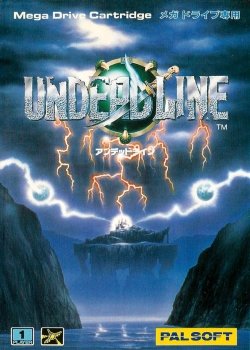
What is it?
North American gamers likely aren't familiar with this vertically-scrolling shooter since it never got released here, but European and Japanese Mega Drive owners have been harried by it for twenty-six miserable years and counting. You're Leon, a wandering warrior pressed by King Fahrenheit II (deposer of King Celsius I, or so I heard) to stop the evil Count Brahzen from resurrecting a living weapon responsible for nearly destroying the world several thousand years ago. Possessing either testicles with the density of uranium or brains with the density of porridge, Leon marches off to certain death to avert a Final Fantasy VI, Kefka-runing-the-planet-level calamity. On his mission Leon traverses a forest, cemetery, ancient ruins, the nearby mountains, an underground cavern, and the local sewers (WTF?!) to acquire six different magical forces to bolster his abilities. Assuming he beats his way through all of them without acquiring a plethora of diseases, he can besiege Brahzen's castle and face the mad Count.
Why it's on this list:
I have no proof to back up my hypothesis, but as far as I can tell, Undead Line is the result of T & E Soft engineering the living hell out of some Necronomicon-summoned demon until they were left with an abomination not even a mother could love that would still fit on a 16-bit cartridge. Leon might be a badass, but with only 3 hit points, three lives, no mid-stage checkpoints, no passwords, and no cheat codes, he needs a true badass at the controller to see his mission through. Spoiler alert: that ain't you, buddy.
Standard enemies are damage sponges, most requiring several hits to dispatch. Power-ups come from treasure chests littering the environment, but their contents cycle only when shot, meaning you need to be careful on the firepower if you want to make sure you get the right item. Because the designers obtained degrees from Asshole Tech, you'll not only die from running into an unopened chest, but there are also power downgrades mixed in--one errant sword toss separates you from the life restoring and the life draining potions. Of course, taking a break from shooting means more enemies and more bullets given the opportunity to separate your intestines from your body, so good luck picking up the desired item in the heat of battle. It's not technically a 'bullet hell' shooter, but if you paused the screen at the right time it would look it to the casual observer.
Difficulty Rating: 9.75/10.
Undead Line is callous to the point of sadism. Like many Mega Drive games it offers a choice of difficulty levels, but in reality it's asking how fast you want your life to be over. Choose 'Easy' if you want any hope of finishing one level, 'Normal' if you're capable of retaining a neutral emotional level despite a severe beating, 'Crazy' only if you're the Buddha himself returned from Nirvana to show us all the path, and 'You Would Not Like Me When I Am Angry' if you've ever been mistaken for the Incredible Hulk.
Pattern memorization is normally helpful for navigating a shooter, but with Undead Line's power up system capable of screwing you over at the most inopportune times, memorizing patterns is only half the battle. Unless you possess the eyes of a hawk, ears of a wolf, strength of a bear, and speed of a puma, you'll only drive up Leon's insurance premiums (and fail to be Bravestarr). There are no differences between the two versions other than the on-screen language, so don't think importing a Japanese edition will make it easier on you. Undead Line eats games like Fatal Labyrinth and Shadow of the Beast for breakfast--surviving even five minutes will test all but the most battle-hardened 16-bit veterans.
10) Target Earth (1990, NCS/Dreamworks Games)
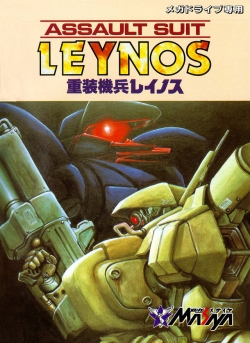
What is it?:
Known as Assault Suits Leynos in Japan, this is the sequel to Cybernator / Assault Suits Valken on the Super Nintendo so already it has a reputation to live up to. This is a 2D side-scrolling mech combat game where you pick your load-out of normal and special weaponry, and advance through the stage, attacking everything you see and dodging enemy fire. Unlike other games of this type, Target Earth sometimes sends reinforcements your way so it doesn't feel like you're a one-man army. They're not much use, and will generally serve only to soak up some bullets before dying, but it's nice to see Earth sent helpers for this suicide mission.
Along with the normal ground-pounding stages, you'll also encounter low-gravity stages that operate like side-scrolling shooters where you can zip to your heart's content. Suit up and stop the terrorist uprising before it reaches Earth--we're counting on you, soldier! As an aside, I will point out that Assault Suits Leynos is the full, uncensored version of the game. The changes are minor, but if you want to see the excised carnage (and don't mind all the Japanese text), go ahead and import this one.
Why it's on this list:
Target Earth makes Contra look inviting. From its opening stage on Ganymede, with the initial aerial bombardment followed by a mass of incoming warships and cyborgs, Target Earth puts the pedal to the metal and expects you to keep up. Enemy AI is ruthless, and you'll swear those battle cruisers are using aimbots to hit you no matter where you go on the screen. Your assault suit has a generous energy meter, and in a huge departure from other run-and-gun games you don't take damage from touching enemies. You will take damage from the resulting explosive decompression when they pop though, so stay well back. Even if you're Deadshot in power armor, you will take more licks than you dish out. Unlike other shooters, your special weapons come with limited ammo, though you'll never be completely unarmed as long as you have your LG Gun or HG Gun. All you need to do to win is survive eight stages of unrelenting abuse and lasers. That's easy enough, right?
Difficulty Rating: 9.25/10.
Assigning a difficulty number to this game is fruitless--it's impossible to translate numbers into raw, burning hatred the way this game can transform a docile living room into a place used to summon a dark god. Target Earth offers three difficulty levels like virtually every other game on this list, and again, they should all be treated like warning labels. "Normal", I am convinced, is the developers misspelling the world 'obnoxious'. "Hard" is a descriptor of this game in the sense that 'wet' is a descriptor of water. "Hyper" is code for 'Marine Drill Sergeant level of cursing enabled'. All it takes is five minutes before you'll offer to sacrifice family members in exchange for the chance to see the end of Stage 2. But does Target Earth care about your craven whimpering? Of course...as much as the average fish cares what Rachel Ray is cooking this afternoon.
09) Chakan: the Forever Man (1992, Extended Play/Sega)
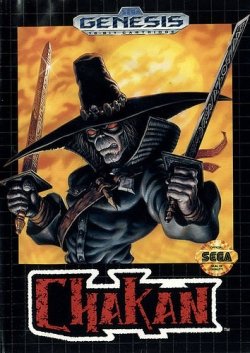
What is it?
The only title on this list based on a comic book. Chakan was a fearsome swordsman, skilled beyond compare. Bragging he was powerful enough to take on even Death himself, Death could not ignore such a challenge. Before their duel, they made a pact: should Death win, Chakan would become his slave forever--if Chakan bested Death however, then Death would honor him with eternal life. Chakan won the fight only to discover eternal life is not the blessing he assumed it would be. For ten centuries the red-eyed, grim-visaged immortal has stalked the Earth. Only when all evil is vanquished will Death free him from the curse. Eight obstacles, the rulers of the terrestrial and elemental worlds, stand in Chakan's way. If he can lay them low, maybe Death will fulfill his end of the bargain. Then again, Death has all the time in the world. What's another millennium or two between bitter enemies?
Why it's on this list:
At first glance, casting the player as an unkillable badass should automatically disqualify Chakan. He's a goddamn immortal. How hard could he really have things? Yeah, that's what Extended Play Productions wants you to think. Chakan is a game so terrifyingly fierce it gives you infinite lives and dares you to play it anyway. Your first clue comes in the options menu, where the game has you pick 'Easy' or 'Hard' difficulty, and since this is a Genesis game you know 'Easy' means 'This is going to hurt', and 'Hard' means 'It be clobbering time!'
Turns out there's a fine between living forever and being indestructible. Chakan can't die, but he can be injured by enemies and harmed by traps. Bottomless pits, lava fields, and oceanic abysses are also hazards of the job. Falling prey to any of these will get you reconstituted for another go, but you'll have to trudge all the way back to where you left off, or choose another path all together. Chakan doesn't point you in the right direction or give you hints, so expect to fail dozens of times until you figure out the best ways to attack the stages, and very rarely is brute forcing your way through one entire area the right decision.
Difficulty Rating: 8.5/10.
Chakan will, if nothing else, ensure you understand just how awful immortality would be in real life. Continue screens serve a useful function in video games by showing you weren't ready for the challenge, giving you time to reconsider how to spend your afternoon. But playing Chakan is like reading Cormac McCarthy's The Road: without chapter breaks, there's no built-in stopping point. It has no passwords or save feature, so once you hit 'power' the only thing that can stop you playing the game is yourself, and that's a significant commitment even for skilled players. Even if you know what you're doing and run the most optimized route, avoiding most of the hidden rooms, you're still looking at a significant time investment before you meet the final boss. Yes you have infinite lives, but that's only half the equation. Have you got infinite time as well? One without the other is useless and you're not getting any younger.
Beating Chakan: the Forever Man will take a toll on your home life for certain. Somewhere there's a guy who's spent the last twenty-four years of his life in a vain effort to see the end of Chakan while the world inched away from it. Life should never come down to a binary choice of 'beating this video game' versus 'touching boobs', but that's exactly what Extended Play Productions did to us in 1992. Also, what kind of asshole includes stage timers in a game with a protagonist who has literally nothing but time? I'd say screw those guys with a rhinoceros, but history ironically condemned Extended Play to create nothing but soccer games until their closure in 1997, a fate only mildly worse than death, sowe'll call it even.
08) Ghouls 'n Ghosts (1989, Capcom/Sega)
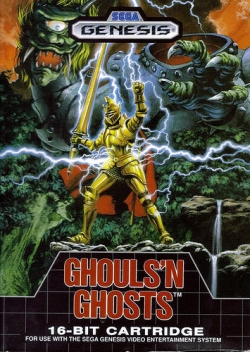
What is it?
Raise your hands, everyone who knew this would make the list. Yeah, when Capcom gives one of the hardest games on the NES a 16-bit makeover for the Genesis, you know you're in for a world of pain and suffering rarely encountered outside the belly of the almighty Sarlaac. Ghouls 'n Ghosts is the sequel to the original Ghosts 'n Goblins, and the brave Arthur must once again blaze a path through all the run-down, monster-infested areas of his country to rescue his beloved princess and defeat the evil Loki, who is not played by Tom Hiddleston in this game, so quit your fan-girling.
Between you and victory stand ten stages, six ridiculously overpowered bosses, innumerable minor minions, and yes, even the weather. When the wind, rain, and the very ground itself unite with the Prince of Darkness to spell your doom, you know this ain't no ordinary haunted hay ride through the cemetery.
Why it's on this list:
Oh, I dunno...maybe the fact Arthur can only take two hits before dying, it's easy to accidentally swap a weapon you like to one that's less effective, enemies come at you from every angle imaginable, and the boss monsters took a few side-levels in the 'Shitlord' class? This was a launch title for the Genesis, a fact which should indicate just how few cares Capcom had when it came to driving gamers insane from the beginning. But Ghouls 'n Ghosts is far from a graphical retread of old territory. It introduces a slew of new play mechanics, including a magic system based on the power level of your armor and what weapon you're wielding, and auto-scrolling levels which keep moving whether or not you want to travel onwards. Rest stops are few and far between, and you're never quite sure when a bridge will collapse under you or a rope of fire drop from a burning ceiling.
The game gives you a choice of difficulty, unlike the NES version which pitched you off a cliff and expected you to learn how to fly on the way down, but the difference between 'Practice' and 'Professional' turns out to have little impact beyond how hard you want your first trip through the game to be. Either way it's a franchise staple that you have to complete these games twice, so really you're better off setting it to 'Professional' from the get-go and just dealing with the added difficulty. Even going 'Professional' won't keep you from repeating stages if you reach the final boss without the right weapon though.
Difficulty Rating: 8/10.
Ghouls 'n Ghosts will thrash you within inches of your life from the moment you turn the game on, but the beatings are tempered slightly by the infinite continues at your disposal, and the frequency of checkpoints on your journey. Like the original, anyone with more free time than common sense can sit down and hurl themselves at it repeatedly until they give up. Pattern memorization is the name of the game when it comes to Ghouls 'n Ghosts, and while you'll spend an awful lot of time dying, once you learn those patterns you can fly through the game like it ain't no thing. Until you do though, expect to enjoy a lot of boxer shorts action with your free-ballin' hero. Approaching any Capcom game without a healthy load of respect is a recipe for disaster, but that's doubly true for Arthur's outings.
07) Streets of Rage 3 /Bare Knuckle III (1994, Sega)
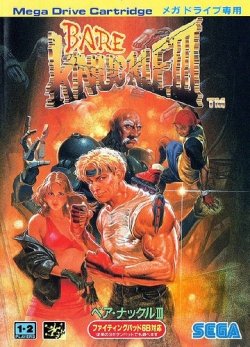
What is it?
As you can probably tell, this is the third game in the Streets of Rage series, or Bare Knuckle if you're playing the Japanese version. You know the story: four buddies come together outside of official channels to bust up the local crime syndicate one spinning back-kick at a time. You'd think by now this would be old hat, but Streets of Rage 3 is more than just a re-skinned Final Fight. This trilogy-closer sets the difficulty bar for 16-bit brawlers and dares anybody else to come close. You beat the first two games? Congratulations, you made it through the training grounds. Time to take off the kid gloves and rumble in the concrete jungle.
Why it's on this list:
Sega made an early name for itself with the first game in this series, which could more than compete with the likes of Double Dragon and other similar titles on the NES. SoR 2 added and expanded the original's ideas. SoR 3 perfected the art of furious beatings, and will not hesitate to lay the harshest reality check on you since the day you realized adults didn't have access to infinite money. It has a learning curve generously described as 'brutal'; though all the basics remain the same, there are plenty of new things the game expects you to master. It also offers four different endings, and only by playing through on Hard and satisfying two separate victory conditions will you qualify for the best.
Difficulty Rating: 8.5/10.
There was never a Streets of Rage 4--upon completion, Streets of Rage 3 looked upon its works and wept for there were no more worlds left to conquer. Because everyone deserves to feel like a failure as much as I do, the link in the game's title leads not to one video but a six video playlist of one guy beating Streets of Rage 3 with every single character on Hard mode without dying over the course of nine hours.
I have no more words.
06) Comix Zone (1995, Sega)
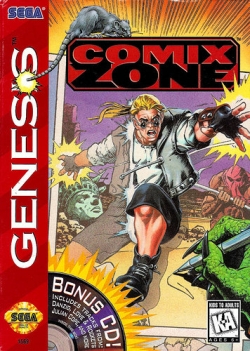
What is it?
Comic artist Sketch Turner is having a truly bad day. Mortus, the main bad guy in Sketch's 'Comix Zone' book has pulled off the ultimate 'Take On Me' tribute and erupted from the pages of the comic alive and well. Because he's the primary antagonist, 'being nice' isn't in his vocabulary and he sentences Sketch to imprisonment in his own gritty, post-apocalyptic comic. Now alone in a world he crafted, it's up to Sketch with occasional help from his pet rat 'Roadkill' to navigate every panel of his storybook world, deal with the threats, and acquire the goods necessary to end Mortus's plan. Failure means a million rabid fans will never see the next issue, and will be forced to read Spawn or Youngblood--it was the 90's, after all. Hmmm...compared to that, death looks positively inviting.
Why it's on this list:
'Comix Zone' never stops breaking the fourth wall. It's ingenious and maddening all at the same time, as Mortus antagonizes Sketch from the other side of the page, adding in new monsters and problems on the fly simply by drawing them in. Good thing living in a rough New York City neighborhood prepared Sketch for this eventuality, since the man can unleash punch-and-kick combos like nobody's business. That said, Comix Zone is no walk in the park. There are puzzles to solve, enemies to beat up, multiple paths through each page, and a bevy of hilarious comic-style sound effects to lighten the mood. The main issue dogging new players will be the rate at which Sketch uses up his health, as even simple actions like breaking down doors with his fists cost him precious ink. Completing the first three pages each will earn you one continue, but beyond that you're at the mercy of Mortus and your controller to finish the saga.
Difficulty Rating: 8/10.
While not as hard as some of the other games on this list, Comix Zone still holds it own for unique presentation if nothing else. Sketch's limited inventory combined with multiple ways to navigate each area and the variety of puzzles within combine to make this far more difficult than your average beat 'em up. Finishing Comix Zone requires the player to develop a sort of extra sense about things, and be prepared for surprise after surprise as Mortus never leaves you alone. While it isn't overly long (Sketch needs only navigate six total pages), there are a ton of platforms, traps, and enemies comprising each page, making every panel a miniature level in and of itself. Of course the developers throw in the old Sega trope of the timed boss battle at the end which determines the ending you get, so it's possible to beat the game and still lose. The ultimate insult though may come from buying the limited edition, which was packaged with a twelve-track music CD featuring tunes by Danzig, Lords of Acid, and MC 900-foot Jesus among others, in case you wanted to subject yourself to Sketch's personal mix tape.
05) Wings of Wor/Gynoug (1991, NCS/Dreamworks Games)
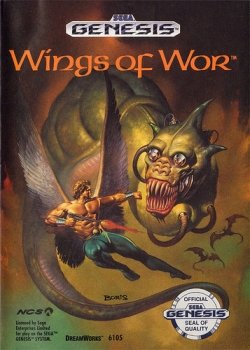
What is it?
I live in North America, but had I lived in Japan or Europe in 1991, that's exactly the question I'd be asking, as in, "What the hell's a 'Gynoug'?" Since I live in a country that gives games actual titles instead of words that sound like dermatological diseases, I've known Wings of Wor to be a side-scrolling shooter like Gaiares since my formative years. It seems like such a basic concept: six stages, simple power-up system, mid- and end-stage bosses, we've seen it all before. And yet Wings of Wor is utterly unlike any other 16-bit SHMUP I've seen.
Most of these games, while having reasonably bleak storylines, are still bright, flashy, impressive, and come to happy endings. Wings of Wor does not: you play a statue animated by a god to fight a bevy of hideously deformed and robotic foes across a half dozen stages of muted color palettes and backgrounds that inspire only hopelessness--seriously, you fight through a sewer, a brain-meltingly hot fire zone, and the bottom of an ocean populated by shipwrecks among others. Then there are the bosses, which can only be described as half-man, half-machine steampunk nightmares brought to life. If H.R. Giger made a Gradius clone, it would look like this. Fans of Abadox on the NES will feel right at home.
Why it's on this list:
Playing Wings of Wor is a struggle, and I mean that in the nicest possible way. Everything about the game is well put together, the controls are responsive, the power-up system is intuitive, the stages are immersive, the music is fitting, but great bouncing bollocks, I have never played a more depressing shooter in my life. Whatever traumatized the developers as children, they failed to have worked through it with this title--you can tell because they went on to create Cho Aniki, where the boss of stage five is nothing but a screaming, eyeless, armless human head and torso attached at the spine to a dick the size of Wyoming.
It offers you four difficulty modes ranging from 'Easy' to 'Hyper', but it's just a placebo effect--Wings of Wor will end you handily no matter what setting you choose. Then, just when you think it's all over, you fight the final boss and watch the ending. That is the very definition of 'depressing', NCS. Thank you very much. Then it plays the 'Hey, why not start the whole game over, but at an even higher level of difficulty!' card for the ultimate cock-punch.
Difficulty Rating: 7.75/10.
Wings of Wor is stupid hard until you've learned the patterns, and you're unlikely to sail through its short six stages without a considerable time investment. The stage bosses have no problem filling the sky with more lead than a Marine live-fire exercise, and what's worse they all have special weak points that often can only be damaged at certain times, making the battles more drawn out than they might normally be. Basic enemies in most stages take multiple shots from your standard weapon to bring down, even at full power. Special weapons are limited in number, and like every other shoot 'em up out there, dying relieves you of all but your base weapon, although you keep it powered up so at least you've got that going for you.
The one thing that messed with my head the hardest are the stage effects where the screen warps, bends, and deforms. These changes actually gave me a headache until I got used to them. Suddenly seeing the screen tilt 15 degrees up and down forces your brain to process just one more thing in the middle of a game where you're already asked to deal with too much, and the game only waits about two minutes before it unleashes the first one on you in the middle of stage one. Wings of Wor is the first game I've ever needed a Dramamine to cope with, and I've played N2O for the PlayStation. Any game that can mess with my head to the point I worry about holding in my lunch deserves a bump on the difficulty scale.
04) Alien Soldier (1995, Treasure/Sega)
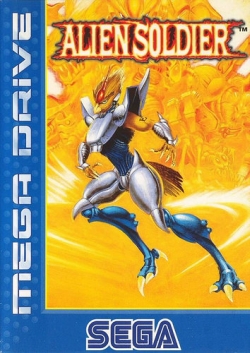
What is it?
Treasure is responsible for some of the best-loved shooters of all time: Gunstar Heroes, Radiant Silvergun, Silhouette Mirage, Ikaruga...all classics, all hard as hell, yet none of them touch the absurd complexity and difficulty contained within Alien Soldier.
You're Epsilon-Eagle, a genetically-enhanced bird warrior who's turned from his life of crime and now seeks revenge against his old employers. Standing between him and total victory are twenty-five stages (no, that isn't a mis-count) of combat in the style of Contra, only without the infinite ammo. Make every shot count or you won't live to see the whites of Z-Leo's eyes in your crosshairs.
Why it's on this list:
Let this just sink in for a moment: Alien Soldier has a spot in the Guinness Book of World Records under 'Most Bosses In A Video Game'. While early stages end with a single boss battle, the fiend you fight at the end of stage twenty goes through a whopping five different forms, and even after that knock-down, drag-out encounter there are five more levels to go. And remember, your ammo is limited. All of it. You don't even get a 'really weak default gun' to fall back on. Out of ammo? Suck it down and try again.
You get pick four choices from a list of six different guns to take into battle before each level, but like real life, Alien Soldier demands the right tool for the right job, and picking the proper gun(s) for a given level can literally be the difference between a cakewalk or a death sentence. And did I mention you're fighting a time limit as well as everything else the game can throw at you?
Difficulty Rating: 7.5 - 14/10.
For the first time, I must give a variable-rank in this category. Alien Soldier offers multiple difficulty levels, from Super Easy all the way up to Super Hard, but even the lowest one won't hesitate to clip your wings if you don't know what you're doing. Many games like this expect you to master one or two special abilities, but Treasure programmed the game such that unless you learn and utilize literally every special move in Epsilon-Eagle's arsenal, you're doomed to failure. You can customize your experience or even handicap yourself even further by picking from a variety of information displayed in the info box at the top of the screen. Normally this defaults to a bar depicting your life meter, your ammo level, and the boss's life meter but it's possible to make some or even all of these depicted in raw numbers as opposed to bars, or even turn them off if the game isn't kicking your ass hard enough for your tastes. Surviving a trip through Alien Soldier's gauntlet on Easy is enough to warrant praise, but if you wish to ascend to the ranks of gaming demigodhood, let's see you do it with all the info bars turned off and the difficulty set to Super Hard. A more vicious ass-kicking on the Mega Drive, you will not find.
03) M.U.S.H.A. (1990, Compile/Seismic Software)

What is it?
The acronym for Metallic Uniframe Super Hybrid Armor, duh.
MUSHA was programmed by the same people who brought The Guardian Legend to the NES, only this time they left out all the planet exploration bits to concentrate solely on the 'blowing shit out of the sky' aspect, with more cut-scenes. One of the most elegant and beautifully-crafted vertically-scrolling shoot 'em ups to grace a sixteen-bit system, MUSHA belongs in every serious gamer's retro library.
Why it's on this list:
Shooters like it make up an enormous part of this list. By this point I wasn't sure I should give this slot to another one, but there's no denying MUSHA's ability to thrash more asses than the headmaster of a British boarding school. Attacks come from all directions, and Compile didn't limit those incursions to just the top, bottom, left and right sides of the screen. Enemies will use the Z-axis as well, rising up from the ground or dropping in from above, and the environments are fantastically rendered to allow for such things. Level three's introduction is a perfect example, as the floor beneath your mech falls away to reveal a vertigo-inducing drop into a canyon carved out by a lava river. Rather than just popping, several of your enemies, when defeated, spiral down into the magma making for a more satisfying demise. Between enemies, on-screen hazards, variable-speed stages, and bullet-sponge bosses, MUSHA can antagonize gamers of any skill.
Difficulty Rating: 7.5/10.
MUSHA also has the dreaded 'died and lost all my power-ups, so I should probably restart' mechanic endemic to this this genre, although it's kinder than most by offering your mech the ability to take several hits before exploding. It also rewards you with mini guardians if you collect enough power-ups, and these guardians can be arranged in a variety of ways to upgrade your firepower or block incoming enemy fire. Juggling these guys is both a blessing and a curse since the optimal position for them often changes throughout the stage and fixing them means dividing your attention.
It offers three weapon types (Fire, Lightning, and Water), and each weapon has multiple power levels obtained by picking up multiples of the same, but in the chaos it's easy to accidentally scoot across a different one and find yourself downgrading to something you didn't want. By the final stage, normal enemies turn into armored dreadnoughts that shrug off even level three firepower. And of course it wouldn't be a Compile game without trolling the player with the 'here's a secret boss after the final boss' trope. Far harder games can be found, but few of them are as rewarding to play if you're willing to invest the time as MUSHA.
02) Contra: Hard Corps/Probotector (1994, Konami)
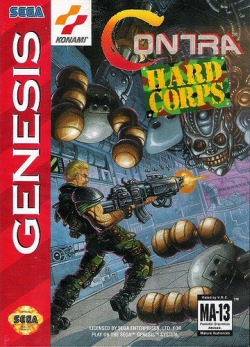
What is it?
If you're unfamiliar with Contra, I need you to take a deep breath, close your eyes, and apologize for your rectalcephaly. What are you even doing here? What am I doing here? What are any of us doing here and what does it all mean? Don't answer! This is a list of difficult Genesis games not difficult philosophical problems, and when it comes to Contra: Hard Corps, if you're thinking, then you aren't shooting, and if you aren't shooting then you're dying.
Why it's on this list:
Because even when you're shooting you're dying. Did you find the original Contra a struggle? Did Super C give you alien-induced nightmares? Does the mere mention of Contra III:The Alien Wars cause you to break out in hives? Has your blood pressure finally normalized from the experience that is Operation C on the Game Boy? If you answered 'yes' to one or more of those questions, I have bad news. Contra: Hard Corps will end you, desecrate your corpse, then hunt your loved ones. It gives you a choice of four playable characters, each with personalized arsenals, strengths, and weaknesses. It gives you choices throughout the game, meaning each play-through can see you entering different territory and fighting different enemies based on your actions. It then it laughs at you for believing this will make any difference at all in the end as it reduces your heroes to a thick red spray.
Difficulty Rating: 10/10.
The Japanese edition includes namby-pamby crap like characters who can take multiple hits before expiring and a whopping 70-life cheat code that could guarantee success to a squirrel, so we're talking exclusively about the North American and European releases here. Perfect ratings are few and far between, but honestly even if Contra: Hard Corps didn't deserve it, I'd still award it a ten out of fear it would come for my sack. Hard Corps is the most accurately-named game on this list, mainly because Sega never released anything called "Relentless Testicle-Stomping Simulator". Seeing the end of even the first stage will take most players through a full set of lives the first time, but finishing all 10+ levels, beating the final boss, getting the good ending, and seeing those credits roll is the kind of assignment Navy SEALs would balk at. Contra: Hard Corps is the game you use to prove you have nothing left to prove.
Until, that is, you decide to play...
01) The Immortal (1993, Electronic Arts)
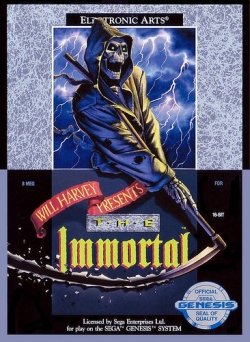
What is it?
A goddamn lie.
Chakan: The Forever Man had the courtesy to put you in control of a dude who will literally live forever as the title claimed. The Immortal, on the other hand, casts you as a guy so delicate his genes are made of powder. It's like all the powers-that-be pointed their skeletal fingers, and declared, "Fucketh this dude in particular."
You play as the apprentice to the wizard Mordamir, and everything in life is just dandy until Mordamir goes dungeon delving and fails to come out again. What's an apprentice to do but brave the endless, horrific, violent, evil labyrinth himself in an isometric action RPG? Wait, I have an even better idea: how about make careful note of that area and then never fucking go anywhere near it ever?
No?
Okay then.
Why it's on this list:
Other games on this list will wreck the on-screen protagonist, whether it's in a hail of lasers, a flurry of punches, or a dearth of food, but none takes such sadistic delight in annihilating the player's sanity as does The Immortal. Things that in most games would be normal actions, like reading an item's description or walking across the floor, consign your protagonist to the most inconceivably brutal demises ever captured in sixteen bits. If 'Death Bingo' was a thing, you could fill six cards by the end of the second level alone. Of course this being The Immortal, the only thing you'd win would be another ignominious ass-kicking so let's not give the designer any more ideas, shall we?
There is no more suitable cover art for a Genesis title. If you bought The Immortal expecting daisy-filled fields and cuddly puppies, you have no one to blame but yourself (and maybe your optometrist). The Immortal gives you one single piece of help on your entire quest, and it's the ability to put in a password and continue later. Trust me, you'll cling to that password like a baby to his blanket until you reach the point where you say, "Fuck you, worms! No more!"
Difficulty Rating: 15/10.
No, that's not a typo; each one of my middle fingers is worth exactly 7-and-a-half points on the 'Screw You!' scale. The Immortal was not 'developed', it was shat into existence by a being composed of pure hate. When giving a video game to prisoners of war would raise hell with Amnesty International, something has gone terribly wrong. Playing it is the gaming equivalent of kicking over a line of hawgs then taunting the bikers, "What are you gonna do about it?".
The Immortal skewers you with arrows, drops you down pits, melts you in acid, exposes you to poisonous mushrooms, murders you in hand-to-hand combat, impales you on spears, immolates you in flames, feeds you to spiders, drowns you in water, electrocutes you with lightning, and then it really begins to torture you. Do you have the instruction manual? I hope you do, because otherwise you're going to miss out on a number of important hints, tips, and control explanations (like holding 'C' while pressing right and left to dodge in combat) essential to beating the game. But even that isn't enough--it'll destroy you in the very first room if you walk on the wrong tile! When you can out-Dark Souls Dark Souls twenty years before there is a Dark Souls, where do you go from there? Congratulations Will Harvey and Electronic Arts: you managed to publish the most fiendishly difficult game in Sega's 16-bit library. Your prize is death.
Don't worry about claiming it.
With any luck, it'll find you first.
I wrote this article originally for RetroGamingMagazine.com--it appears here on Steemit in an updated/edited form. The original can be found here. Thanks for reading!
Of all the games listed I have played a few of them and Comic Zone was the hardest to play because it was just now play friendly. you might get 1 cell further each time but I don't think I ever finished that one after years of playing it.
Comix Zone is so unforgiving. It was hard as balls in the 90's when I first played it, it was just as freakin' hard on the PS3 when I tried it again. It's awesome, I love the style, but damn is it willing to break your arm at a moment's notice. :)
Yeah those retro classics did not get easier when they were ported for re releases.
cool post , I played contra & Ghouls 'n Ghosts
@originalworks
The @OriginalWorks bot has upvoted and checked this post!
Some similarity seems to be present here:
http://retrogamingmagazine.com/2016/09/07/fifteen-most-difficult-genesis-games/
This is an early BETA version. If you cited this source, then ignore this message! Reply if you feel this is an error.
Thanks, OriginalWorks! This article did indeed appear on RetroGamingMagazine, and I was lax in my citation. :)